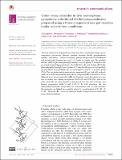Files in this item
Order versus disorder in two isomorphous pyrazolone-substituted diethyl propanedioates prepared using a three-component one-pot reaction under solvent-free conditions
Item metadata
| dc.contributor.author | Shreekanth, Tharangini K. | |
| dc.contributor.author | Yathirajan, Hemmige S. | |
| dc.contributor.author | Kalluraya, Balakrishna | |
| dc.contributor.author | Foro, Sabine | |
| dc.contributor.author | Glidewell, Christopher | |
| dc.date.accessioned | 2020-10-06T14:30:06Z | |
| dc.date.available | 2020-10-06T14:30:06Z | |
| dc.date.issued | 2020-10 | |
| dc.identifier | 270575768 | |
| dc.identifier | 5f324b78-186b-49ec-95fa-1e55d045d655 | |
| dc.identifier | 000577165000014 | |
| dc.identifier | 85092444969 | |
| dc.identifier.citation | Shreekanth , T K , Yathirajan , H S , Kalluraya , B , Foro , S & Glidewell , C 2020 , ' Order versus disorder in two isomorphous pyrazolone-substituted diethyl propanedioates prepared using a three-component one-pot reaction under solvent-free conditions ' , Acta Crystallographica Section E: Crystallographic Communications , vol. 76 , no. 10 , pp. 1605-1610 . https://doi.org/10.1107/S2056989020011676 | en |
| dc.identifier.issn | 2056-9890 | |
| dc.identifier.uri | https://hdl.handle.net/10023/20731 | |
| dc.description | Funding for this research was provided by: University Grants Commission, New Delhi. | en |
| dc.description.abstract | Two new substituted propanedioate esters have been synthesized using a three-component solvent-free thermal reaction between diethyl propanedioate (diethyl malonate), 5-chloro-3-methyl-1-phenyl-1H-pyrazole-4-carbaldehyde and an aryl azide, forming two new C—C bonds in a single step. The products diethyl (RS)-2-[(4-bromophenyl)(5-methyl-3-oxo-2-phenyl-2,3-dihydro-1H-pyrazol-4-yl)methyl]propanedioate, C24H25BrN2O5 (I), and diethyl (RS)-2-[(4-chlorophenyl)(5-methyl-3-oxo-2-phenyl-2,3-dihydro-1H-pyrazol-4-yl)methyl]propanedioate, C24H25ClN2O5 (II), are isomorphous, with Z′ = 2 in space group P21/n. The two independent molecules in compound (I) are both fully ordered, while each of the independent molecules in compound (II) is disordered, but in different ways. In one molecule of (II), the N-phenyl ring is disordered over two sets of atomic sites having occupancies 0.635 (10) and 0.365 (10), and in the other molecule the ester function is disordered over two sets of atomic sites having occupancies 0.690 (5) and 0.310 (5). In both structures, the two independent molecules adopt different conformations and, in each structure, the molecules are linked into complex sheets by a combination of N—H⋯O, C—H⋯O and C—H⋯π(arene) hydrogen bonds. Comparisons are made with some related structures. | |
| dc.format.extent | 1077371 | |
| dc.language.iso | eng | |
| dc.relation.ispartof | Acta Crystallographica Section E: Crystallographic Communications | en |
| dc.subject | Synthesis | en |
| dc.subject | Pyrazoles | en |
| dc.subject | Crystal structure | en |
| dc.subject | Disorder | en |
| dc.subject | Molecular conformation | en |
| dc.subject | Hydrogen bonding | en |
| dc.subject | Supramolecular assesmbly | en |
| dc.subject | QD Chemistry | en |
| dc.subject | DAS | en |
| dc.subject.lcc | QD | en |
| dc.title | Order versus disorder in two isomorphous pyrazolone-substituted diethyl propanedioates prepared using a three-component one-pot reaction under solvent-free conditions | en |
| dc.type | Journal article | en |
| dc.contributor.institution | University of St Andrews. School of Chemistry | en |
| dc.identifier.doi | https://doi.org/10.1107/S2056989020011676 | |
| dc.description.status | Peer reviewed | en |
This item appears in the following Collection(s)
Items in the St Andrews Research Repository are protected by copyright, with all rights reserved, unless otherwise indicated.

